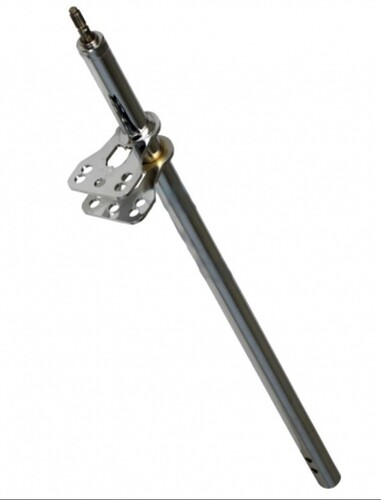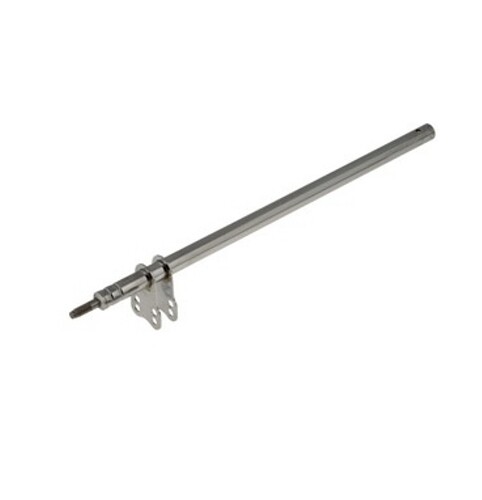I get that the holes closest to the steering shaft will result in slower steering and opposite for holes furthest from the shaft but I’ve heard conflicting theories on which results in more ackermann. Has anyone actually tested this or know for certain?
Holes furthest from the shaft = more Ackermann
I also appreciate your correct spelling of Ackermann 
Further question:
Is moving to outer hole on steering shaft same effect as moving to inner hole on steering spindle?
I always understood that the holes on the steering shaft are for rate and the holes on the spindle are for ackermann. The heim location on the spindle relative to the kingpin is what adds or reduces ackermann. The more inboard the heim is relative to the kingpin, the more Ackermann. Of course rate can be adjusted on the spindle too by have the heim closer or further from the kingpin. Further away would be less turning rate.
Ackerman increases the further you move from your pivot point location, be it steering shaft or the spindle king pin.
So full Ackerman would be furthest away from shaft on the steering shaft “leaves,” and furthest away from king pin on spindle.
Ackerman is a great adjustment with drivers that are uncomfortable or to “force” young drivers to slow their hands down a bit. For more experienced drivers it seems to be less impactful aside from personal preference as often these drivers will simply ‘drive around’ steering discomfort.
This is steering rate Eric. Ackermann is basically the rate the inside tire is turned vs the outside tire.
Imagine if your heim was directly behind the kingpin bolt on your spindle. No matter if that heim position was one inch back from the kingpin or 3 feet back from the kingpin those tires will always be Exactly parallel when the steering wheel is turned. Zero ackermann.
Taking this to extremes as you can see.
Now if your inner tie rod heim was a millimeter away from the steering shaft your wheels would not turn much. If the inner heim was a foot away from the shaft they would go lock to lock with minimal input on the wheel. This is steering rate. The same can be done on the spindle.
Ackermann is increased or decreased with the position of the outer heim relative to the kingpin. If it is straight back from the kingpin (not possible on karts) you would have parallel steering with no Ackermann. As the relative position changes you get Ackermann. The further inboard the heim position gets relative to the kingpin, the more Ackermann you get.
Of course on karts there are only a few positions, and like camber/caster pills one usually affects the other. So these holes generally adjust rate and Ackermann.
Older karts had both inner track rod ends/ heims on one bolt and all the Ackermann effect came from the stub axles/ spindles.
Then karts came out with the ’ new’ Ackermann steering where part of the effect came from the two bolt attachment of the two heims
at the steering column.The further apart laterally the two bolts are, the greater the effect.
Not sure on the original question, tend to the view that using the holes nearer the column will give slightly more effect.
Next question .What effect does more or less Ackermann have on the way the kart performs / handles?
Sorry for bringing this back, but how does moving the tie rods side to side on the steering column change how the steering feels. I had to replace a steering column on my kart this week, and the new column I had measures a quarter inch narrower width wise while being the same vertical distance from the column. When I got out on track, the kart felt more sensitive to steering input, but wheel felt lighter than before.
Aaron part of what you may be experiencing here is moving side to side changes subtly the angle of the tie rod relative to horizontal. Imagine the hypotenuse of a triangle, a longer distance from steering shaft mounting point to spindle stub will have less “drop” and give a more direct steering feel, while the opposite is true with a more narrow (or inward) steering setting.
We’ve experimented at times with not changing mounting location but instead adjusting where the tie rod is mounted on the shaft with spacers or by bolting it upwards or downwards and have had the same sort of effect.
I am getting old. My first karts in the early 90s had holes at the pitman arm of the shaft that were in the center only and the tie rods connected one on top the other.
The closer to the shaft the less steering output per unit steering wheel input - sensitivity or rate. Ackerman was not impacted. The angle between the kingpin and the outer tie rod connection point alone determined Ackerman (and you had one hole so we hoped our chassis maker was smart!) The more the angle pointed in, the more Ackerman (toe out increase per unit steering change from center) Also, if you kept the angle at the stub axle the same but connected closer longitudinally it would also increase the amount of steering output per unit input of the wheel - increasing sensitivity or rate.
Ackerman in this case would stay the same it just would be way more sensitive. Fast forward some years and add in pitman arms that not only get your connections longitudinally adjustable away from the shaft but ALSO split the tie rods away from each other latitudinally. Now you have potential to create Ackerman effect here as well! And like at the stub axle, the angle (centerline out) is actually what increases Ackerman… essentially more spread apart increases Ackerman, higher and lower On arm is just sensitivity / steering rate.
The complexity now is we can adjust Ackerman at the stub axle AND the pitman arm… this is precisely because it is a pitman and not a linear rack! So, the combining effects of the two, which can plot differently throughout the steering position range, based on the sensitivity and Ackerman used at the pitman and the sensitivity and Ackerman used at the stub axle, are what you end up with.
So in summary, moving inner tie rod connections ‘down’ from steering shaft and/or outer connections ‘up’ towards spindle axis increases turning sensitivity / steering rate. Moving tie rod connections ‘in’ from spindle axis and/or moving connections apart from each other at pitman increase Ackerman.
The math was tricky before… now it’s really tricky!!! Note- not all karts will have adjustments for all of these possibilities… our karts have rate and Ackerman available at pitman but only Ackerman at the stub axle, but has 5 possible Ackerman settings. I think comp kart for example has all possible adjustments at pitman and also at the stub axle; five holes at stub axle in a number five dice pattern. OTK has only Ackerman at the stub axle and only two holes, but the pitman has options for sensitivity and Ackerman.
And yes TJ I just realized I misspelled Ackermann everywhere but I’m just too lazy to fix it 
Edit: I just looked at an otk shaft and it only has 4 holes, basically to change sensitivity.
Hello all,
Bringing one up from the past. I just switched my steering column and did not realize the size difference in the width of the connection plate on the steering column. I went from a wide to a narrow plate meaning I had to lengthen my tie rods to get the same toe.
I am finding the kart has a lot of oversteer now. I’m wondering if this could be the reason. Does this mean I have increased or decreased ackermann and is there any counter adjustments that I can do to help reduce oversteer from this?
I included pictures of both.
You have increased Ackermann with the wider spacing, which could indeed be part of your oversteer problem.
Thank you, I’ll offset it with other adjustments.
He says he went from a wider to a narrower spacing reducing ackermann effect from the column. Could be balanced out by moving the outer track rod ends to holes on the steering arms nearer the centre of the kart, if available?
Ah yeah, misread the post, good catch John. And yes, could offset it by moving the tie rod on the spindle mount.
So I have reduced the ackermann? Meaning it should actually understeer?
I had to lengthen the tie rods as the plate is now narrower than my old column.
Setup is conditional to the rest of the kart, tires, track conditions etc. What creates understeer in one kart on one day might create oversteer on another kart on another day.
You have changed the balance of the kart though with that Ackermann change, so how that manifests could be different depending on the situation.
Sounds good I’ll try moving it to the other hole on the spindle.
Thank you

